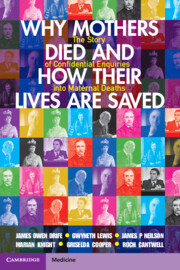 Why Mothers Died and How their Lives are Saved
Why Mothers Died and How their Lives are Saved Published online by Cambridge University Press: 05 April 2023
The contagiousness of childbed fever was first recognised by Alexander Gordon in Aberdeen in 1795. Epidemics occurred in cities, rural communities and lying-in hospitals. In the USA Oliver Wendell Holmes caused uproar by saying doctors were carriers of disease. In 1848 Semmelweis reduced the death rate in Vienna’s maternity hospital by introducing handwashing but was not recognised until later. In the 1870s panic took hold in England. Midwives were charged with homicide and the hospital death rate in London was 2.6%. In Europe Billroth described the streptococcus and Pasteur showed that it caused puerperal sepsis. In Britain Listerian asepsis transformed surgery and reduced the death rate in lying-in hospitals. In the 1930s Colebrook worked on aseptic maternity practice. In Germany Domagk discovered prontosil and in 1936 Colebrook demonstrated its life-saving effects. Fleming discovered penicillin and Florey and Chain turned it into an antibiotic. Maternal mortality fell rapidly. By 1982-4 antibiotics had abolished deaths from puerperal sepsis but by 2006-8 sepsis was again the leading cause of Direct death and the Reports emphasised the need for constant vigilance.
To save this book to your Kindle, first ensure [email protected] is added to your Approved Personal Document E-mail List under your Personal Document Settings on the Manage Your Content and Devices page of your Amazon account. Then enter the ‘name’ part of your Kindle email address below. Find out more about saving to your Kindle.
Note you can select to save to either the @free.kindle.com or @kindle.com variations. ‘@free.kindle.com’ emails are free but can only be saved to your device when it is connected to wi-fi. ‘@kindle.com’ emails can be delivered even when you are not connected to wi-fi, but note that service fees apply.
Find out more about the Kindle Personal Document Service.
To save content items to your account, please confirm that you agree to abide by our usage policies. If this is the first time you use this feature, you will be asked to authorise Cambridge Core to connect with your account. Find out more about saving content to Dropbox.
To save content items to your account, please confirm that you agree to abide by our usage policies. If this is the first time you use this feature, you will be asked to authorise Cambridge Core to connect with your account. Find out more about saving content to Google Drive.